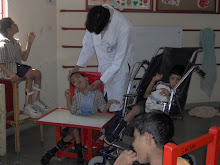Autistic children like routine
Autistic children are most comfortable in repeating activities they are comfortable with. The dentist can use this knowledge to his/her advantage by:
- Offering parents and children the opportunity to tour your dental office, so that they may ask questions, touch equipment, and get used to the place.
- Allow autistic children to bring comfort items, such as a blanket or a favorite toy.
- Children with autism need sameness and continuity in their environment. A gradual and slow exposure to the dental office and staff is therefore recommended.
Treating the autistic child may be a challenge to you; but the parent knows the habits and tendencies of the child. Spend some time talking to the parent before the procedure - it is time well spent.
The First Visit - Getting started...
- Make the first appointment short and positive.
- Approach the autistic child in a quiet, non-threatening manner. Don’t crowd the child.
- Use a “tell-show-do” approach to providing care. Explain the procedure before it occurs. Show the instruments that you will use. Provide frequent praise for acceptable behavior.
- Invite the child to sit alone in the dental chair to become familiar with the treatment setting.
The nature of the disease makes it essential for the dentist to explain each step of the procedure. An autistic individual likes order and can , even in the absence of mental retardation, find abstract expalnations hard to follow.
- Autistics will want to know what’s going to happen next. Explain what you’re doing so it makes sense to them. Explain every treatment before it happens.
- Always tell the autistic child where and why you need to touch them, especially when using dental or medical equipment.
- Talk in direct, short phrases. Talk calmly. Autistics take everything literally – so watch what you say. Avoid words or phrases with double meanings.
A child may be calmed by moderate firm pressure. The use of a body wrap or a bedsheet to cover the child tightly can greatly enhance the cooperation of the child.Light pressure, such as air from a syringe, however can greatly agitate the child.
Sensory responses of an autistic child may be exaggerated
Autistic children may have an irritability to bright light or some form of hyperaccusis.
- Keep the light out of the child's eyes.
- Make sure the child can tolerate the high pitched sound of the airotor; you may be better off using a micromotor handpiece
Tempting as it may be to directly post an autistic child under general anesthesia DCSN strongly reccomends that the child be given every opportunit y to cooperate on the dental chair. It is also imperitive that the pediatric dentist spots early signs of oral disease and acts swiftly to minimize the operative treatment required by the child.
- Some children will need sedation or general anesthesia so that dental treatment can be accomplished. Sedation of autistic children who are 8 years and older simply does not work.
The following article provides excellent background reading on autism, though its primarily written for the physician, some of you may find it worth reading








No comments:
Post a Comment